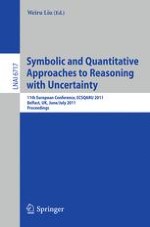This book constitutes the refereed proceedings of the 11th European Conference on Symbolic and Quantitative Approaches to Reasoning with Uncertainty, ECSQARU 2011, held in Belfast, UK, in June/July 2011.
The 60 revised full papers presented together with 3 invited talks were carefully reviewed and selected from 108 submissions. The papers are organized in topical sections on argumentation; Bayesian networks and causal networks; belief functions; belief revision and inconsistency handling; classification and clustering; default reasoning and logics for reasoning under uncertainty; foundations of reasoning and decision making under uncertainty; fuzzy sets and fuzzy logic; implementation and applications of uncertain systems; possibility theory and possibilistic logic; and uncertainty in databases.
